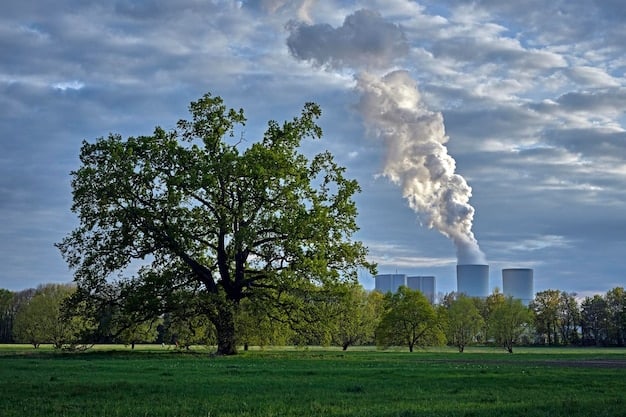Understanding the US Position on Climate Change Negotiations in 2025

Understanding the US Position on Climate Change Negotiations in 2025 involves analyzing its commitments to international agreements, domestic policies aimed at reducing emissions, and its stance on financial and technological support for developing nations in their climate efforts.
The world is watching as nations prepare for critical climate change negotiations. Understanding the US Position on Climate Change Negotiations in 2025 is crucial for grasping global efforts to combat climate change.
The Evolution of US Climate Policy
The United States has a complex history regarding climate change. Understanding its past actions is essential for predicting and interpreting its future stance in international negotiations.

Historical Commitments and Withdrawals
The US has, at various times, been a leader in climate action, while at other times, it has distanced itself from global agreements. This pattern is due to changes in administrations and differing political priorities.
- Kyoto Protocol: The US signed but did not ratify the Kyoto Protocol, an early international effort to reduce greenhouse gas emissions.
- Paris Agreement: The US initially joined the Paris Agreement, setting emission reduction targets, but later withdrew before rejoining under a new administration.
- Domestic Policies: Various US administrations have implemented policies such as the Clean Power Plan and investments in renewable energy to address climate change domestically.
These shifts have significant implications for international trust and the US’s credibility in leading global climate efforts.
In conclusion, the United States’ approach to climate policy has been anything but consistent. This historical volatility underscores the importance of closely monitoring its current position and future actions in international negotiations.
Current US Climate Goals and Targets
Currently, the goals and targets set by the US are ambitious and necessary to combat climate change. Understanding these targets is vital as the US prepares for international climate negotiations.
Nationally Determined Contributions (NDCs)
As part of the Paris Agreement, the US has outlined specific goals to reduce emissions. These goals are critical for keeping global warming below the thresholds set by scientists.
- Emission Reduction Targets: The US has pledged to achieve a significant reduction in greenhouse gas emissions by 2030, using 2005 as a baseline.
- Sector-Specific Goals: Various sectors, including energy, transportation, and agriculture, have specific targets and strategies to contribute to overall emission reductions.
- Long-Term Strategies: The US is developing long-term strategies to achieve net-zero emissions by mid-century, aligning with global efforts to limit warming.
Meeting these targets requires significant investments and policy changes across various sectors.
These targets demonstrate the seriousness with which the US views its responsibilities under the Paris Agreement. Achieving these goals will require policy changes from the US.
Domestic Policies Driving Climate Action
Domestic policies are the backbone of US climate action. Without strong domestic support, international negotiations would lack credibility.
Legislative and Executive Actions
The US government has been implementing various legislative and executive actions to combat climate change. These actions aim to reduce emissions, promote clean energy, and enhance resilience to climate impacts.

- Clean Energy Standards: Many states have adopted clean energy standards, requiring a certain percentage of electricity to come from renewable sources.
- Investment in Renewable Energy: Tax credits, grants, and loans are used to incentivize the development and deployment of renewable energy technologies.
- Regulations on Emissions: The Environmental Protection Agency (EPA) sets regulations on greenhouse gas emissions from various sources, including power plants and vehicles.
These policies not only reduce emissions but also stimulate economic growth and create jobs in the clean energy sector.
In conclusion, the US utilizes both legislative measures and executive actions to drive climate action domestically. These policies are vital for setting a strong foundation for international credibility.
The US Stance on Climate Finance
Climate finance is a contentious issue in international negotiations. The US’s willingness to contribute financially to climate change efforts greatly influences the outcome of these negotiations.
Commitments to International Funds
Developed countries have pledged to provide financial support to developing nations to help them mitigate and adapt to climate change. The US’s role in fulfilling these commitments is critical.
- Green Climate Fund: The US has pledged contributions to the Green Climate Fund, an international fund that supports climate projects in developing countries.
- Bilateral Aid: The US provides bilateral aid to developing countries for climate-related projects, such as renewable energy development and adaptation measures.
- Technological Support: The US also supports technology transfer to help developing countries adopt clean technologies and build resilience to climate impacts.
However, the level and consistency of US contributions have been subject to political debate and uncertainty.
In summary, the actions of the US are vital to climate finance. Without funding from developed nations, many countries will lack the resources necessary to make a difference.
Challenges and Opportunities for US Leadership
The US faces unique challenges and opportunities in leading international climate efforts. Its political landscape, economic structure, and technological capabilities all play a role.
Political Polarization and Public Opinion
Climate change remains a politically polarized issue in the US. The views on climate change vary significantly across political lines. This polarization creates challenges for implementing consistent and ambitious climate policies.
- Public Awareness and Support: While awareness of climate change is increasing, public support for climate action varies, influenced by factors such as education, income, and political affiliation.
- Policy Implementation: Policy decisions, such as carbon pricing or regulations on emissions, often face strong opposition, leading to delays or weakening of measures.
- International Cooperation: The US’s ability to lead international climate efforts depends on bipartisan support and a willingness to engage constructively with other nations.
Overcoming political polarization and building broader public support are essential for effective climate action in the US.
The US has a wide political divide. Overcoming this divide is one of the greatest hurdles for the US to be a leader in addressing climate change.
Predicting the US Position in 2025 Negotiations
Predicting the US position in climate negotiations requires an analysis of ongoing trends, policy developments, and political factors. Several scenarios are possible, depending on these influences.
Potential Scenarios and Priorities
The US’s stance in 2025 negotiations will be influenced by domestic and international factors. The positions depend on which party holds the presidency.
- Continued Commitment: If the current administration remains in power or is succeeded by a like-minded one, the US is likely to continue prioritizing climate action.
- Shift in Approach: If a different administration takes office, the US may weaken its commitments and prioritize economic interests over climate concerns; however, this is not guaranteed.
Understanding these potential scenarios is crucial for stakeholders seeking to influence the outcome of climate negotiations.
In conclusion, multiple factors determine the US position in climate negotiations. Political will, economic conditions, and global pressure will influence the final position of the US.
| Key Point | Brief Description |
|---|---|
| 🌍 US Climate Goals | Ambitious emission cuts by 2030, net-zero by 2050. |
| 💰 Climate Finance | Pledges to Green Climate Fund, but funding is inconsistent. |
| 🏛️ Domestic Policies | Clean energy standards and emission regulations vary by state. |
| ⚖️ Political Challenges | Climate policy highly polarized, impacting global leadership. |
Frequently Asked Questions
▼
The U.S. aims to achieve a 50-52% reduction from 2005 levels in economy-wide net greenhouse gas pollution in 2030, positioning itself towards a net-zero emissions economy by 2050.
▼
Strong domestic policies like clean energy standards enhance US credibility in international negotiations, demonstrating commitment and paving the way for collaborative agreements with other nations.
▼
Climate financing is a cornerstone. By funding projects in developing nations, the US fosters cooperation and trust, ensuring global participation in addressing climate change effectively.
▼
Yes, shifts in administration can lead to fluctuations in climate policies. This can affect the US’s reliability and leadership in international climate efforts due to changing priorities.
▼
To overcome this divide, the US can foster broader public support through education, emphasize economic opportunities in clean energy, and seek bipartisan agreements towards climate goals.
Conclusion
Understanding the US Position on Climate Change Negotiations in 2025 requires an in-depth look at its historical commitments, current policies, and potential future scenarios. The actions of the US, both domestic and international, will significantly impact the success of global climate efforts.





